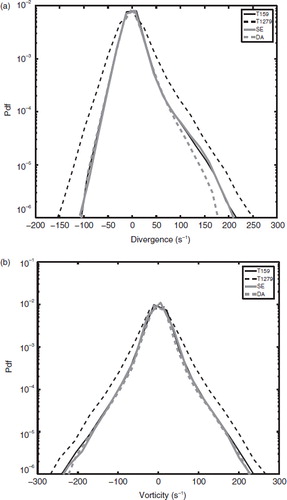 ?Mathematical formulae have been encoded as MathML and are displayed in this HTML version using MathJax in order to improve their display. Uncheck the box to turn MathJax off. This feature requires Javascript. Click on a formula to zoom.
?Mathematical formulae have been encoded as MathML and are displayed in this HTML version using MathJax in order to improve their display. Uncheck the box to turn MathJax off. This feature requires Javascript. Click on a formula to zoom.Abstract
A scaled version of the European Centre for Medium-Range Weather Forecasts (ECMWF) spectral hydrostatic forecast model (IFS) has been developed with full physics using an Aqua planet configuration. This includes Kuang et al.'s Small Earth Diabatic Acceleration and REscaling (DARE/SE) approach bringing the synoptic scale a factor γ closer to the convective scale by reducing the Earth radius by γ, and increasing the rotation rate and all diabatic processes by the same factor. Furthermore, the scaled version also provides an alternative system to DARE/SE, dubbed ‘Deep Atmosphere Diabatic Acceleration and REscaling’ (DARE/DA), which reduces gravity by a factor γ and thereby increases the horizontal scale of convection by γ, while only weakly affecting the large-scale flow. The two approaches have been evaluated using a T159 spectral truncation and γ = 8 with the deep convection scheme switched off. The evaluation is against the baseline unscaled model at T1279 spectral resolution without deep convection parametrisation, as well as the unscaled T159 model using the deep convection parametrisation. It is shown that the DARE/SE and DARE/DA systems provide fairly equivalent results, while the DARE/DA system seems to be the preferred choice as it damps divergent modes, providing a better climatology, and is technically easier to implement. However, neither of the systems could reproduce the motion range and modes of the high-resolution spectral model. Higher equivalent horizontal resolution in the 1–10 km range and the full non-hydrostatic system might be necessary to successfully simulate the convective and large-scale explicitly at reduced cost.
1. Introduction
Deep convection parametrisation is a key element of general circulation models (GCMs) owing to its crucial role in stabilising the atmosphere. Given the continuous increase in computing resources, it should be possible to run routinely GCMs at kilometric resolution without a deep convection parametrisation within the next decade. However, as increasing model resolution is computationally expensive, one would like to determine the coarsest resolution possible that would accurately resolve deep convective motions. At the high resolutions being envisaged, not only the simulations but also the data storage and processing are extremely costly, rendering extensive experimentation and developments impractical on current computer systems. In order to circumvent these limitations, Wedi and Smolarkiewicz (Citation2009) set up a prototype reduced planet version of the IFS, but without model physics. The prototype enabled the development and efficient evaluation of the non-hydrostatic dynamical core of the model. Furthermore, Bechtold et al. (Citation2013) have applied the reduced planet to cloud resolving simulations of mesoscale convective systems. However, without the rescaling of the large-scale flow and the physics only short and idealised simulations are possible.
Our goal here is to develop a scaled version of the IFS with full physics that permits deep convective motions while maintaining a realistic synoptic circulation. Kuang et al. (Citation2005) have suggested Small Earth Diabatic Acceleration and REscaling (DARE/SE). The DARE/SE approach bears the distinctive advantage over traditional high-resolution equatorial channel simulations (Shutts, Citation2006; Holloway et al., Citation2012) that it also permits to simulate (emulate) the global climate and in particular the wave interaction between the tropics and the middle latitudes. The application of DARE/SE reduces both the spatial and temporal scales of large-scale circulations by making the radius of the Earth smaller by some factor (often denoted γ) and increasing the rotation rate by the same factor, which is referred to by Kuang et al. (Citation2005) as the DARE factor. The response time of the convective systems is also shortened by this factor in order to maintain the appropriate balance between the convection and the large-scale circulations. This is achieved by multiplying all diabatic fluxes, microphysical process rates and precipitation fall velocities by the DARE factor (Kuang et al., Citation2005; Peters and Bretherton, Citation2006). This approach has also been referred to as the Small Earth approach by Garner et al. (Citation2007).
Pauluis et al. (Citation2006) proposed the hypohydrostatic rescaling, which is referred to by Kuang et al. (Citation2005) as RAVE (Reduced Acceleration in the VErtical). In the hypohydrostatic equation, the inertia of vertical motion is increased.
The equivalence of the DARE/SE, RAVE/hypohydrostatic and DARE/DA systems is not necessarily preserved once the model's physical parameterisations are included, as noted by Pauluis et al. (Citation2006) in Section 2.5, p. 491: ‘While the three rescalings in Section 2.2 are mathematically equivalent for the compressible Navier-Stokes equation with prescribed forcings, they do differ as far as the implementation of the physical processes is concerned’.
Here we elaborated a scaled version of the IFS hydrostatic model with full physics using an Aqua planet configuration. This includes the DARE/SE approach bringing the synoptic scale a factor γ closer to the convective scale by reducing the Earth radius by γ, and increasing the rotation rate and all diabatic processes by the same factor. In addition, the scaled version also provides an alternative system to DARE/SE, dubbed ‘Deep Atmosphere Diabatic Acceleration and REscaling’ (DARE/DA), which reduces the gravity by a factor γ and thereby increases the horizontal scale of convection by γ, while keeping the large-scale flow unaffected. Section 2 describes the adopted scaling approach. Section 3 presents the results from Aqua planet hydrostatic simulations with T159 (125 km) and T1279 (16 km) resolutions to assess whether DARE/DA low-resolution models can reproduce high-resolution simulations. A summary and discussion are given in Section 4.
2. Scaling framework
2.1. Dimensionless parameters
The external dimensionless parameters that must be held invariant during the vertical or horizontal rescaling are as follows. The scaling of the planetary radius R
a, gravity g and rotation speed Ω leads to the scaling of horizontal length scale L, scale height H, time scale and the two dimensionless Rossby and Lamb numbers, Ro and La, respectively.
1
1
2
2
3
The atmospheric scale height H is related to gravity by , where R is the gas constant and T is the temperature. Moreover, in the current hydrostatic vertical coordinate system, density and hydrostatic pressure are invariant.
The Rossby number Ro measures the ratio of the horizontal acceleration to the Coriolis force4
4 with U the synoptic horizontal velocity.
Verkley and van der Velde (Citation2010) expressed the Lamb number as5
5
The Rossby (Ro) and Lamb (La) numbers are kept invariant under the scalings in eqs. (1)–(3) that have γR=γΩ. Interestingly, La does not involve the horizontal wind speed which is an internal parameter. This means that when conserving La, the wind field on the scaled planet is the same as on the unscaled planet.
2.2. DARE/SE and DARE/DA scalings
The strategy to resolve deep convection is to reduce the gap between the convective and synoptic scales while maintaining a realistic interaction between the convection and the synoptic circulation. This can be achieved either by (1) reducing the synoptic scale, referred to as DARE/SE, or (2) increasing the convective scale, referred to as Deep Atmosphere Diabatic Acceleration and REscaling (DARE/DA).
On one hand, the DARE/SE approach uses γR=γΩ=γ and γg=1. It requires the increase of radiation and surface fluxes in order to accelerate the diabatic forcing of convective-scale motions by the factor γ. A key aspect of DARE/SE is that the vertical scale remains unchanged. Thus, even though the convection is driven more strongly by a factor γ, the convective scale is unchanged, and hence ideally is a factor γ closer to the synoptic scale. Furthermore, the DARE/SE scaling increases the speed of all microphysical processes, including the precipitation fall velocity, by the factor γ in a way that is consistent with large-scale processes. On the other hand, DARE/DA uses γR=γΩ=1 and . It also requires the increase of radiation and surface fluxes in order to offset the decrease of gravity. It must be noted here that DARE/DA also increases the precipitation fall velocity by the factor γ in order to conserve the ratio between the precipitation fall speed and the synoptic vertical velocity.
Table and 2 give a summary of the DARE/SE and DARE/DA scalings. A few precautions have to be taken in the physics concerning the internal constants that have been given absolute values instead of generally scaled values. In the model this affects the microphysical time-scales (), as well as the turbulent length scale (L
turb) and the entrainment (E) and detrainment (D) rates in the convection parametrisation.
Table 1. DARE/SE and DARE/DA dynamics scaling
Table 2. DARE/SE and DARE/DA scaling of the radiation (RAD) and surface heat (HEAT) fluxes, the microphysical time-scales (), the precipitation fall speed (V), as well as the turbulent length scale (Lturb
) and the entrainment (E) and detrainment (D) rates in the convection parametrisation
2.3. Convective mass flux response to DARE/SE and DARE/DA scalings
The rate at which convective instability is removed can be expressed by the tendency of the convective available potential energy PCAPE (J m−3) through either a relaxation form or through environmental compensating environmental subsidence so that the convective mass flux M (kg m−2 s−1) becomes apparent (Bechtold et al., Citation2014)6
6
The integration in height coordinates z is between cloud base and cloud top and is the Brunt–Väisälä frequency, where
is the large-scale potential temperature. Note that eq. (6) is valid for both resolved and parametrised deep convection.
On one hand, the DARE/SE scaling reduces and hence increases the lhs of eq. (6). This in turn forces a greater convective mass flux M in a way to maintain eq. (6) in balance. On the other hand, in order to conserve the lhs of eq. (6), the DARE/DA scaling increases the convective mass flux M in a way to offset the decrease of gravity.
The maximum growth rate σmax for linearised convective instability can be estimated by with K
max the maximum total horizontal wavenumber and m
min the minimum vertical wavenumber (MacDonald et al., Citation2000; Garner et al., Citation2007). The DARE/DA scaling increases the vertical scale
by a factor γ while reducing ∣N∣ by the same factor. The latter point implies that the maximum growth rate σmax is invariant under the DARE/DA scaling. The transition to the resolved
occurs when the rescaled hydrostatic-scale vertical velocity
becomes comparable to the large-scale velocity U. Therefore, by choosing
, one can capture the scale
without having to increase the model spectral truncation from K
max to m
min.
3. Simulations of scaled Aqua planet and at variable truncations
3.1. Aqua planet setup
An ideal prototype for exploring the effects of these rescalings on moist convection and its interactions with the large-scale flow is the Aqua planet. In this configuration, as initially proposed by Neale and Hoskins (Citation2000) and recently used by Blackburn et al. (Citation2013) to evaluate GCMs, all the land points are replaced by ocean points such that the surface characteristics are homogeneous over the globe. A further simplification was obtained by fixing the sun over the equator, thus there is no seasonal cycle. The experiments are performed with zonally symmetric sea surface temperatures (SSTs) as boundary condition. For an Earth-like simulation, typically a zonally symmetric SST distribution is chosen peaking at 27°C at the equator and decreasing to 0°C beyond 60° latitude. More specifically, the SST distribution corresponds to ‘QOBS’ in Williamson et al. (Citation2013). The advantage of the Aqua planet is that it avoids the complications of scaling the orography and height of the vegetation for planets of different size.
The general circulation on the Aqua planet and its climate is simulated within the global IFS hydrostatic model starting from a balanced state, using a 6-month spin-up forecast. A four-member ensemble is then generated by integrating the IFS hydrostatic model for 1 yr.
3.2. Reference Aqua planet simulation and observations
a shows the annual mean precipitation (mm day−1) on the real Earth as obtained from the GPCP2.2 dataset, and b shows the results for the reference T159 full Aqua planet with γR=γΩ=γg=1 and with deep convection parametrisation. b exhibits a distinctive intertropical convergence zone (ITCZ) with high rainfall and equatorially symmetric middle-latitude storm tracks in qualitative agreement with what is observed for the real Earth (a).
Fig. 1 Annual mean daily global precipitation (mm day−1). (a) Observations from the GPCP2.2 precipitation climatology dataset. (b) A 1-yr integration at T159 of a four-member ensemble with deep convection parametrisation using the full Aqua planet with γR=γΩ=γg=1.
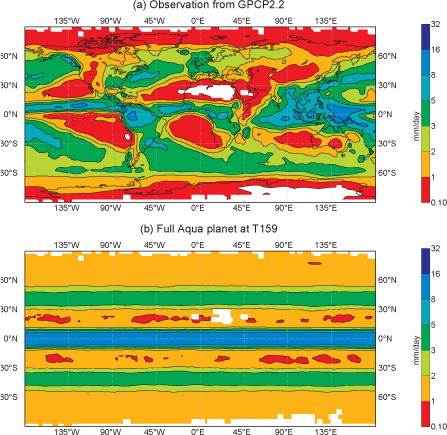
The convectively-coupled waves in the tropical band are analysed in using wavenumber frequency diagrams of the outgoing longwave radiation (OLR). Satellite observations (a) reveal the dominant tropical wave types which are the eastward propagating Kelvin waves and the westward propagating equatorial Rossby wave. The Madden-Julian oscillation (MJO), wavenumber 1–2 and period 20–60 d, is also apparent as a distinct mode. It can be seen that the dominant wave types are reasonably reproduced for the T159 full Aqua planet simulations with deep convection parametrisation (b), but the wave amplitudes are larger than those observed because these waves can freely circumnavigate the equator without being disturbed by land effects.
Fig. 2 Same as , but for the wavenumber frequency spectra of the outgoing longwave radiation with observations from the NOAA satellites. The data has been averaged between 10°S and 10°N, a background spectrum has been subtracted, and only the symmetric part of the spectrum is displayed. Spectra include the theoretical dispersion relations with external gravity wave phase speed as a function of scale height H. The characteristic tropical wave types include the eastward propagating Kelvin waves, the westward propagating equatorial Rossby (ER) waves, and the inertia gravity (IG) waves.
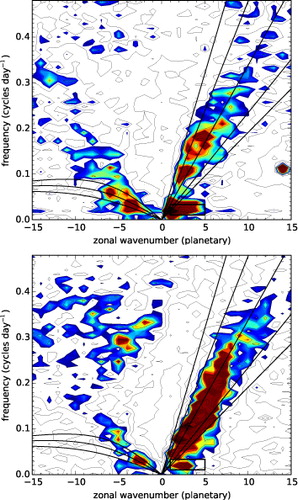
3.3. System configurations, rescaling and spectral truncation
In order to summarise the different system configurations and qualitatively illustrate the effects of spectral truncation and rescaling, we have plotted in for a large part of the northern hemisphere snaphosts of 500 hPa geopotential and horizontal wind and daily mean surface precipitation after 300 d (Earth rotations) when the global circulation is in equilibrium. The maps show characteristic middle-latitude synoptic systems and tropical convective systems. The aim is not to show a close correspondence between the weather systems in the different configurations, these are not deterministic forecasts, but to visualise the characteristic scales of the circulation.
Fig. 3 Snapshots of 500 hPa geopotential (isolines) and horizontal wind (arrows), as well as daily mean total precipitation (mm) (colour shading) after 300 d (Earth rotations) for an area covering a large part of the northern hemisphere: (a) reference Aqua planet system at truncation T159 with deep convection parametrisation, (b) same as (a) but at T1279, (c) Small Planet (SP) system based on (a) but with γR=γΩ=8, (d) Small Planet Shallow Atmosphere (SPSA) system based on (a) but with γR=γΩ=γg=8. Simulations without deep convection parametrisation include unscaled reference runs at (e) T159 and (f) T1279, as well as at T159 with (g) DARE/SE (γR=γΩ=γ = 8 and γg=1) and (h) DARE/DA (γR=γΩ=1 and ). The precipitation fluxes are rescaled proportionally to γ−1.
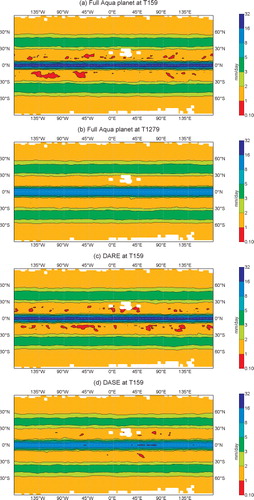
a and b correspond to the full Aqua planet runs with deep convection parametrisation at truncations T159 and T1279, respectively. While the mean circulation and precipitation between these simulations are equivalent, the middle-latitude synoptic systems clearly have a more realistic structure at T1279 showing the characteristic frontal and postfrontal precipitating areas. In c and d are displayed two small-scale systems of the reference T159 run with deep convection (a), using γR=γΩ=8 (c) and γR=γΩ=γg=8 (d). The former is denoted as Small Planet (SP), while the latter is denoted as ‘Small Planet Shallow Atmosphere (SPSA)’. Note that no specific physics rescaling has been performed. Comparing the Small Planet system (c) to the reference (a) one observes a narrowed tropical convergence zone with increased rainfall and a northward shift of the middle-latitude storm tracks (this becomes more evident from zonal mean plots, not shown). However, when in addition to the decreased Earth radius and increased rotation rate also the depth of the atmosphere is reduced (d) the reference T159 simulation can be reproduced, but no gains in terms of numerical cost have been achieved.
Simulations without the deep convection parametrisation scheme are displayed in e–h. These include full planet simulations at T159 and T1279 as well as T159 simulations using the DARE/SE and DARE/DA systems with γ = 8, respectively. Comparing the T159 simulation without deep convection (e) to the corresponding run with deep convection (a) one observes a narrowed tropical convergence zone with unrealistically high rainfall. However, when going to T1279 truncation (f) the results significantly improve and the synoptic and rainfall patterns more closely match those of the reference T1279 run with deep convection (b), though tropical precipitation patterns are still noisier. Finally, concerning the DARE/SE (g) and DARE/DA (h) systems, the results are rather similar to the full planet T159 simulation (e). For the remainder of this article, only the simulations without deep convection parametrisation will be further investigated, as our final goal is to approach the transition to resolved deep convection.
3.4. Explicit deep convection
displays the annual mean precipitation rate for the full Aqua planet with γ = 1 at truncation T159 and T1279 (a and b) but without deep convection parametrisation (only shallow convection parametrisation is active). Also shown is the scaled Aqua planet at T159 using the DARE/SE and DARE/DA configurations (c and d).
Fig. 4 Annual mean daily global precipitation (mm day−1) for hydrostatic integrations without deep convection parametrisation for the full Aqua planet (γR=γΩ=γg=1) at (a) T159, (b) T1279, and the scaled Aqua planet at T159 with (c) DARE/SE (γR=γΩ=γ = 8 and γg=1) and (d) DARE/DA (γR=γΩ=1 and ). The precipitation fluxes are rescaled proportionally to γ−1.
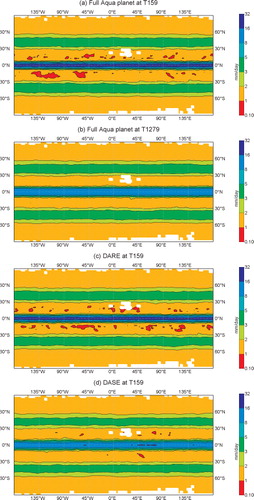
The T159 integration (a) greatly overestimates the equatorial precipitation compared to the T159 control run with deep convection parametrisation (b). In particular, one observes in the T159 run an ITCZ with heavy precipitation peaking around 24 mm day−1 at the equator compared to the T159 baseline run producing around 11 mm day−1. Moreover, DARE/SE (c) essentially only reproduces the results of the T159 integration (a). In contrast, the tropical precipitation rate decreases with DARE/DA (d) and becomes comparable to the T1279 climate (b). Furthermore, the realism of the middle-latitude (precipitation) scaling for DARE/SE and DARE/DA can be conveniently verified by comparing the zonal mean temperature and moisture biases with respect to the reference. The results (not shown) show a very good agreement for DARE/DA while for DARE/SE the zonal mean temperature and moisture field correspond to the reference for latitudes beyond 30°.
The tropical wave spectra of the OLR corresponding to the simulations in are displayed in . Interestingly, the MJO signal, wavenumber 1–2 and period 20–60 d, is weak in all simulations without deep convection at T159 (a) and at T1279 (b) compared to the run with deep convection (b). The Rossby wave signal is particularly weak in all simulations at T159 without deep convection, including DARE/SE (c) and DARE/DA (d), and the inertia gravity mode in the anti-symmetric part of the spectrum is absent (not shown). Furthermore, in the full Aqua planet integration without the deep parametrisation at T159, as well as in DARE/SE (c), there is excessive high frequency spectral noise compared to the control run without deep convection at T1279. In contrast, the high frequency spectral noise is significantly reduced in DARE/DA (d).
In order to further investigate which part of the velocity is affected by the resolution and the scaling, Pdfs of the divergence at 250 hPa and the vorticity at 500 hPa in the tropical band are shown in . All fields have been truncated to T159, in addition for the DARE/SE vorticity and divergence are scaled by a factor γ−1. The essential results from are that (1) the Pdfs of vorticity and divergence are much broader at T1279 than at T159, (2) DARE/SE and DARE/DA are equivalent and essentially reproduce the reference T159 run, and (3) DARE/DA produces smaller positive values of divergence, which is consistent with the smoother spectra and less intense tropical rainfall discussed beforehand. The results for the global velocity fields are very similar (not shown).
4. Summary and discussion
In the continuity of the Small Planet dry dynamic framework by Wedi and Smolarkiewicz (Citation2009) and the DARE/SE approach by Kuang et al. (Citation2005), we have reviewed and explored all possible options of a scaled global model including moist physics. Our final goal of achieving resolved convection at reduced cost could be only partially achieved with the DARE/DA approach.
It must be noted here that the DARE scaling assumes that changing the scale difference between the convective and large-scale systems does not change their method of interaction, as long as some difference in scale remains. Moreover, a difficulty with the DARE approach is that the precipitation fall velocity is rescaled consistently with large-scale motions, and it is therefore impossible to perform the fall velocity rescaling in a way that is consistent both with the small and large-scale processes. Our experience is that DARE/DA does not hugely distort either the deep convection or the large-scale flows and allows the moist thermodynamics and dynamics to naturally interact, provided γ is small enough that the cumulus scale and the large-scale remain well separated. We estimate that a factor γ of order 8 provides sufficient physical realism, while providing efficient high-resolution experimentation.
Therefore, it appears that the DARE/SE and DARE/DA systems provide a consistent rescaling framework. Previously, it was illustrated in Bechtold et al. (Citation2013) that it is possible to have consistent results for either the Small Earth simulation of convective systems or the large-scale circulation; however, representing both at reduced costs appears to be a difficult task. For practical reasons, our preference goes to the DARE/DA system as it essentially relies on the scaling of an external parameter, that is, the gravity. Our experience gained so far indicates that it is difficult to represent with a low spectral resolution DARE/SE or DARE/DA system (1) the coherence of a model with convection parametrisation at the same spectral resolution, and (2) the full spectrum of motions (scales) of a high spectral resolution explicit convection system. However, the full suitability of either the DARE/SE or DARE/DA approach to simulate at low cost the full global circulation and wave interactions has not yet been demonstrated. To do so, one might need to go to higher resolutions (equivalent gridpoint resolutions between 10 and 1 km) and the full non-hydrostatic dynamical core.
5. Acknowledgements
This work was funded by the European Commission's 7th Framework Programme, under Grant Agreement number 282672, EMBRACE project. We warmly thank Anton Beljaars, Piotr Smolarkiewicz and Erland Källén for many helpful discussions and Nils Wedi and Sylvie Malardel for many Aqua planet developments. Our sincere gratitude goes to Michael Hermann from New Mexico University and King-Fai Li from CalTech for providing the wavenumber frequency package.
References
- Bechtold P. , Semane N. , Lopez P. , Chaboureau J.-P. , Beljaars A . Representing equilibrium and nonequilibrium convection in large-scale models. J. Atmos. Sci. 2014; 71: 734–753.
- Bechtold P. , Semane N. , Malardel S . Convection and waves on small planets and the real Earth. ECMWF Newslett. 2013; 135: 14–19.
- Blackburn M. , Williamson D. L. , Nakajima K. , Ohfuchi W. , Takahashi Y. O . The Aqua-Planet Experiment (APE): CONTROL SST simulation. J. Meteorol. Soc. Jpn. 2013; 91A: 17–56.
- Garner S. T. , Frierson D. M. W. , Held I. M. , Pauluis O. , Vallis G. K . Resolving convection in a global hypohydrostatic model. J. Atmos. Sci. 2007; 64: 2061–2075.
- Holloway C. E. , Woolnough S. J. , Lister G. M. S . Precipitation distributions for explicit versus parametrized convection in large-domain high-resolution tropical case study. Q. J. Roy. Meteorol. Soc. 2012; 138: 1692–1708.
- Kuang Z. , Blossey P. N. , Bretherton C. S . A new approach for 3D cloud-resolving simulations of large-scale atmospheric circulation. Geophys. Res. Lett. 2005; 32: L02809.
- MacDonald A. E. , Lee J. L. , Xie Y . The use of quasi-nonhydrostatic models for mesoscale weather prediction. J. Atmos. Sci. 2000; 57: 2493–2517.
- Neale R. B. , Hoskins B. J . A standard test for AGCMs including their physical parametrizations: I: the proposal. Atmosph. Sci. Lett. 2000; 1: 101107.
- Pauluis O. , Frierson D. M. W. , Garner S . The hypohydrostatic rescaling and its impact on modeling of atmospheric convection. Theor. Comput. Fluid Dyn. 2006; 20: 485–499.
- Peters M. , Bretherton C . Structure of tropical variability from a vertical mode perspective. Theor. Comput. Fluid Dyn. 2006; 20: 501–524.
- Shutts G. J . Upscale effects in simulations of tropical convection on an equatorial beta-plane. Dyn. Atmos. Oceans. 2006; 42: 30–58.
- Verkley W. T. M. , van der Velde I. R . Balanced dynamics in the tropics. Q. J. Roy. Meteorol. Soc. 2010; 136: 41–49.
- Wedi N. P. , Smolarkiewicz P. K . A framework for testing global non-hydrostatic models. Q. J. Roy. Meteorol. Soc. 2009; 135: 469–484.
- Williamson D. L. , Blackburn M. , Nakajima K. , Ohfuchi W. , Takahashi Y. O . The Aqua Planet Experiment (APE): response to changed meridional SST profile. J. Meteorol. Soc. Jpn. 2013; 91A: 57–89.


